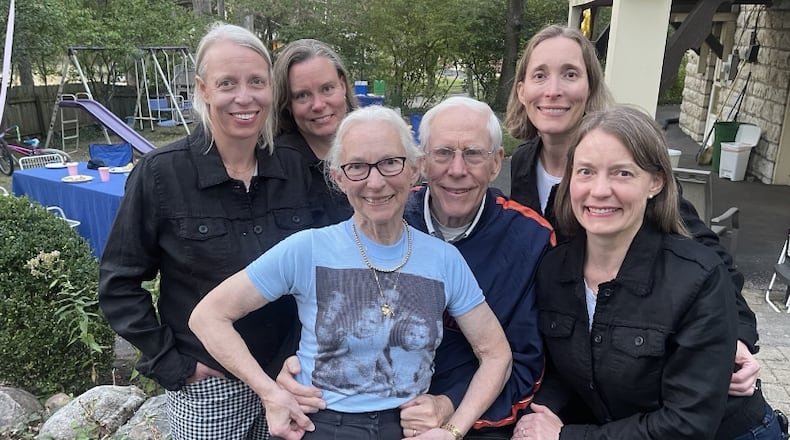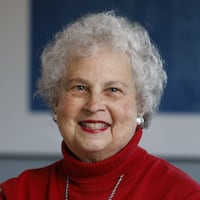Subsequently, four more children joined the Deddens family, including twin boys. Three of the quads still live in Oakwood. Bob and Ruth now have 24 grandchildren.
Last weekend, the family gathered in Darcy’s backyard to mark another major milestone: the quads’ 50th birthdays.
“We are all individuals and like different things so we each had a different cake,” said Molly. “Amy gave us all matching jackets as a birthday present.”
The jackets were a throwback to the days in elementary school when the girls were identically dressed. Their mother sewed all of their matching outfits including swim suits and Halloween costumes. The clothing was color coded so that people could tell them apart: Katy was red or pink, Patty was yellow, Molly was blue, and Amy was green.
In those years, sharing was a given. The quads shared a bedroom with two bunk beds and also shared clothes, underwear, socks and a bathroom.
In 1984, the Deddens family was named the “Saturday Evening Post” magazine’s Family of the Year. The prize was their first computer.
A time for remembering
This birthday weekend was a time for reminiscing, especially about that memorable September day when Ruth and Bob, who’d been expecting triplets, were in for a big surprise. Only three heads had shown up on x-rays during Ruth’s pregnancy.
On the day of their birth, three babies — dubbed Baby A, Baby B, and Baby C — were delivered by Cesarean section. The doctor was beginning to complete the procedure when he felt another baby kicking. It was Baby D.
The infants, six weeks early, weighed 14 pounds in total and were delivered by local Alan Baker and Ronald Loesch.
Credit: Picasa
Credit: Picasa
Three ambulances were waiting at Kettering Memorial Hospital in case the infants needed to be rushed to Children’s Hospital in an emergency. Thankfully, all went well and one by one, as soon as each baby weighed the required five pounds, she was permitted to go home.
Bob Deddens was quoted as saying that he felt like bursting into song and singing “Thank Heavens for Little Girls.”
Adjusting
In anticipation of multiple births, Mrs. Deddens had hired a night nurse. When the woman heard there were now four infants, she declined the job. That left Mom and Dad, Grandma, and 2-year-old sister Darcy to adjust as best they could.
Ruth said she couldn’t have done it without her mother, Eloise Carey, who had volunteered at the hospital for years and had always wanted to work in the nursery. “They’d always assigned her elsewhere but as soon as our babies were born, I asked if my mother could work in the ICU to help out and they agreed,” Ruth said. “She continued to volunteer there for many years after that.”
Ruth said it took about an hour to breastfeed all four girls, and they were on a schedule of needing to nurse every three hours. “So there was precious little time to relax and to get work done that needed to be done,” Ruth remembered.
In an era with no newborn car seats, the Deddens used an old-fashioned baby buggy that had a baby basket. They put all of the girls in the basket with two heads facing each direction.
“The babies and I participated in a P & G disposable diaper test: we got “free” diapers in exchange for our ideas,” Ruth once related. “The original diapers had to be pinned on and my knuckles were bleeding since I was always washing hands so I started using masking tape on the diapers. I also made the suggestion that they add crimping around the legs and waist. P&G ran with both of those ideas.”
Thinking back
Over the years, the sisters have been asked to reflect on the pros and cons of growing up as quads. They all fondly remember the fun times: elaborate birthday parties, riding bikes to the Oakwood pool for swim lessons, involvement in 4-H, cooking and baking in the kitchen. They enjoyed making music together and became their own barbershop quartet, singing songs like “Sisters” in choir. They were a brass quartet in the band as well.
From an early age, said Patty, they were all involved in sports.
“We had our own relay team and other teams would come over gawking at us, asking if we were identical, and many questions: who is the tallest, the fastest, the most popular, if we fought often, if we all had the same favorite color, the same size shoe. These encounters were somewhat overwhelming.”
Because they looked so much alike, people would avoid calling them by the wrong name and didn’t make the effort to get to know them individually. “This made us feel isolated and lonely at times which naturally made our bond as sisters more tight,” said Amy. “We each longed to have people get to know us as individuals.” But overall, she said, it was great fun growing up as a quad and having three sisters the same age.
Patty has noted that one of the challenges over the years has been becoming her own person, separating the “I” from the “we,” and missing the other sisters.
“All the questions and attention from being a quadruplet got old after a while,” she said. “I feel we just wanted to fit in as we got older. My sisters and I have often said that we don’t know how to make friends. We were each other’s friends, and that was easy, but eventually we each desired to have our own friends.”
One of the advantages of being a quad was the Deddens family never had to worry about scheduling play dates or planning activities.
“My children didn’t have the crutch of having a sibling or two or three in the same grade to play with or to double-check the homework assignment,” Molly said. “We were competitive and that pushed us to work hard on our homework and in athletics.”
Molly also appreciates a mother who always wanted to make sure the girls were not labeled as “the smart one or the athletic one or the pretty one.”
“I believe my parents turned down talk show appearance opportunities in order to prevent the media from comparing us,” Molly said. “She also wanted to make sure we were all included. So, if a friend invited one of us over, all four had to be included. When we had our own birthday parties, each of us had our own cake.”
Katy said her parents are amazing role models who continually demonstrate their commitment to family and their Catholic faith by action, not just words.
Her mom, she said, has always been a trailblazer.
“When she was at Oakwood High School, she wanted to be a drummer and although there were girls in the band, there weren’t any female percussionists and she became the first. She went to the University of Cincinnati and ran for student body president, which was unheard of at the time. My father was her campaign manager.”
Ruth was also open to trying new fertility treatments and the result helped ensure what’s been labeled the Deddens’ “Full House.”
Bob puts it this way: “We have four Queens, a pair of Jacks, an Ace high, and a couple of Jokers.”
The Jokers were John-Paul and Elizabeth, who were conceived without infertility drugs.
Turning 50
Molly, who last week took her youngest child to college, said she has mixed feelings about turning 50. “
It’s starting a new phase in my life, seeing changes in my body that aren’t welcome. I now need to wear trifocals,” She feels lucky to have had the unique experience of being a quad. “It was really fun, it was comforting to be a unit of four,” she said. “We were not allowed to fight with each other — we all got along. We cheered each other on. We were all four together all the time. I think it’s neat that the three of us came back to live in our hometown.”
Ruth said the journey was hard at times and sometimes a blur.
“Today I realize how antique everything was then. When we did our infertility treatments at Ohio State, you didn’t know if it was a boy or girl until they were born.”
In looking back over the years, Ruth said there were years that were a day long and days that were a year long.
“But it was miraculous in so many ways, so amazing. It was very special. I would do it again in a minute.”
RARITY OF QUADRUPLETS
Quadruplets are still a rare occurrence in America. According to the CDC, the latest final birth data in 2022 shows 108 quadruplet births. A CDC spokesperson said there were 628 quads in 1998, the peak year; that number has fallen gradually to 128 quads in 2023.
“We do not have data differentiating quadruplets from other multiple births prior to 1989,” said CDC Statistician Joyce Martin. “However, there were approximately 200 births in quadruplet deliveries in the late 1980′s and early 1990′s. These numbers are very likely much larger than those in the 1970s however, because of the impact of fertility- enhancing therapies on multiple birth rates in the 1980′s/1990′s. Since the number of triplet and higher order multiple births more than tripled over this period a conservative estimate of the number of births in quadruplet deliveries in the 1970s would be less than 100.
About the Author








